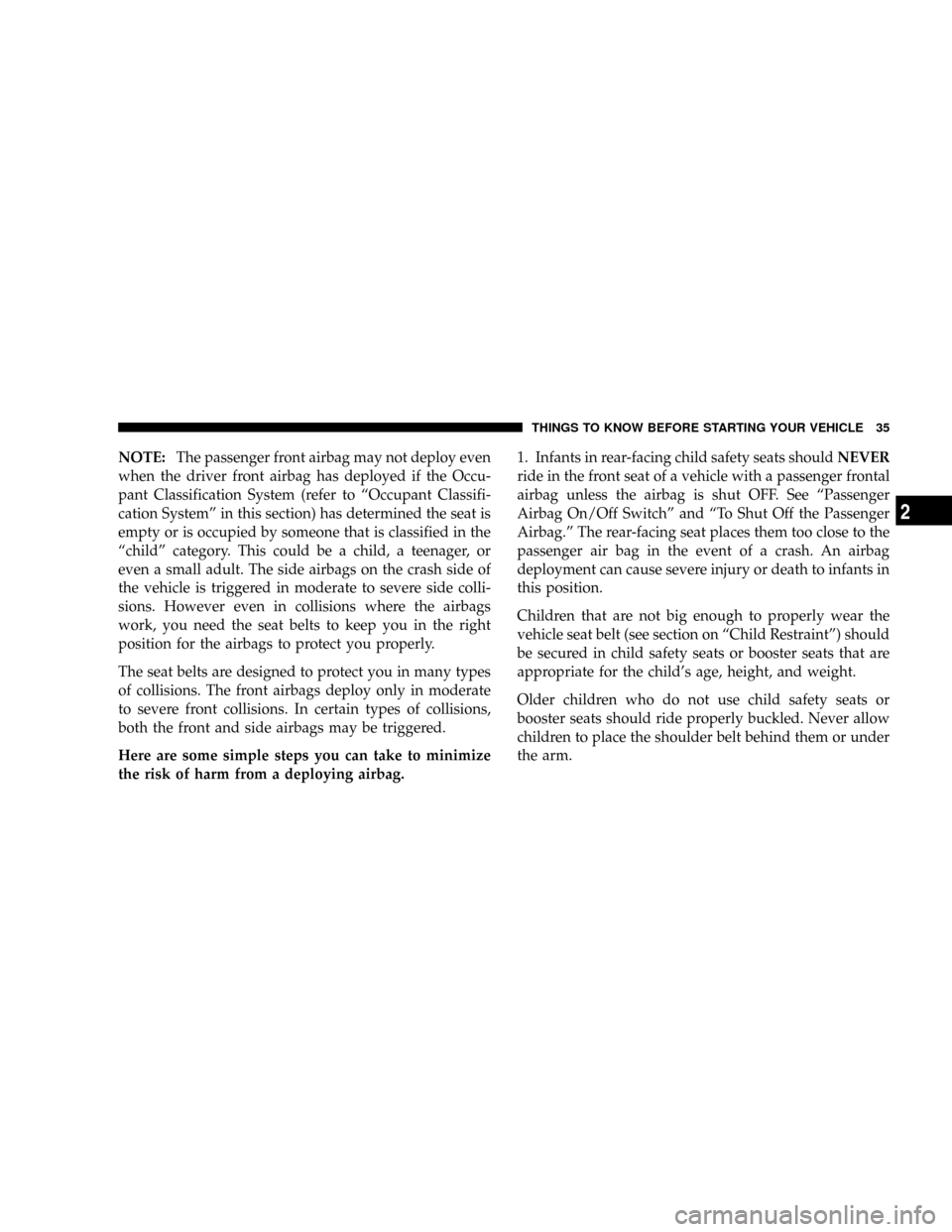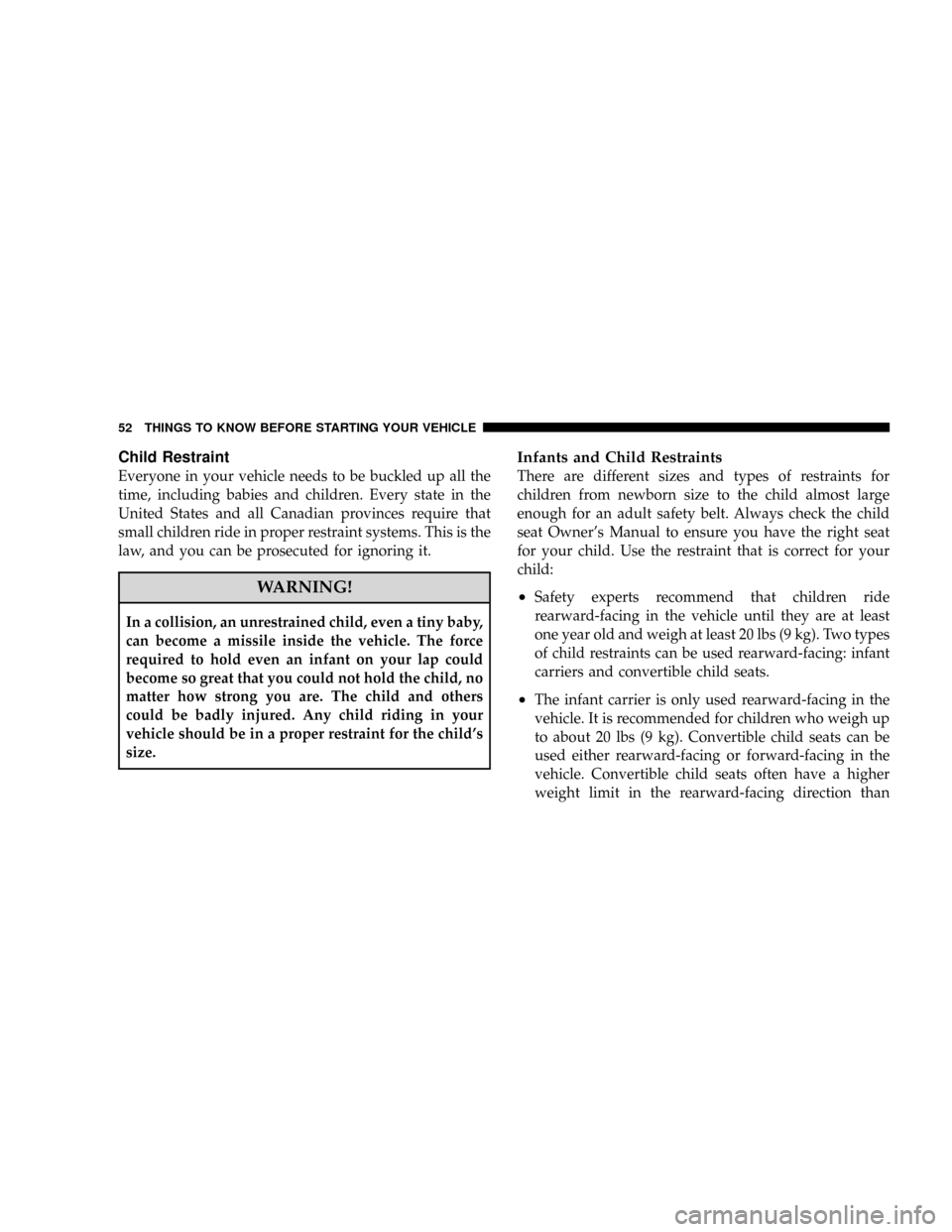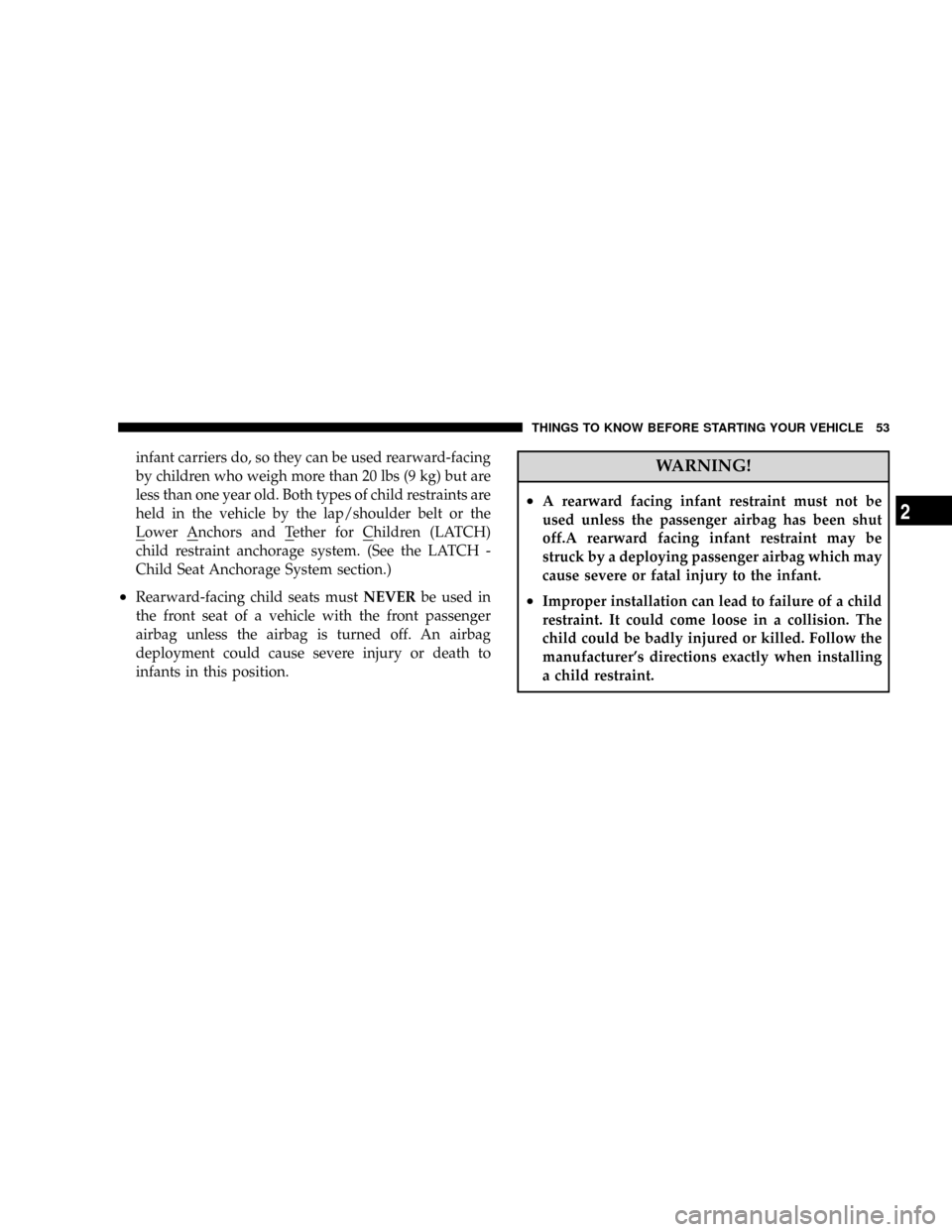2008 CHRYSLER CROSSFIRE seats
[x] Cancel search: seatsPage 37 of 358

NOTE:The passenger front airbag may not deploy even
when the driver front airbag has deployed if the Occu-
pant Classification System (refer to ªOccupant Classifi-
cation Systemº in this section) has determined the seat is
empty or is occupied by someone that is classified in the
ªchildº category. This could be a child, a teenager, or
even a small adult. The side airbags on the crash side of
the vehicle is triggered in moderate to severe side colli-
sions. However even in collisions where the airbags
work, you need the seat belts to keep you in the right
position for the airbags to protect you properly.
The seat belts are designed to protect you in many types
of collisions. The front airbags deploy only in moderate
to severe front collisions. In certain types of collisions,
both the front and side airbags may be triggered.
Here are some simple steps you can take to minimize
the risk of harm from a deploying airbag.1. Infants in rear-facing child safety seats shouldNEVER
ride in the front seat of a vehicle with a passenger frontal
airbag unless the airbag is shut OFF. See ªPassenger
Airbag On/Off Switchº and ªTo Shut Off the Passenger
Airbag.º The rear-facing seat places them too close to the
passenger air bag in the event of a crash. An airbag
deployment can cause severe injury or death to infants in
this position.
Children that are not big enough to properly wear the
vehicle seat belt (see section on ªChild Restraintº) should
be secured in child safety seats or booster seats that are
appropriate for the child's age, height, and weight.
Older children who do not use child safety seats or
booster seats should ride properly buckled. Never allow
children to place the shoulder belt behind them or under
the arm.
THINGS TO KNOW BEFORE STARTING YOUR VEHICLE 35
2
Page 38 of 358

If a child from 1 to 12 years old must ride in the vehicle,
move the seat as far back as possible, shut off the
passenger airbag, and use the proper child restraint. See
the section on ªChild Restraint.º
You should read the instructions provided with your
child restraint or belt-positioning booster seat to make
sure that you are using it properly.
2. All occupants should wear their lap and shoulder belts
properly.
3. The driver and passenger seats should be moved back
as far as practical to allow the front airbags room to
inflate.
4. Do not lean against the door, as the side airbags will
inflate forcefully into the space between you and the
door. (See the section on ªSide Airbagsº)WARNING!
After installing a child safety seat or booster seat on the
passenger seat, do not adjust the back rest forward. This
could cause a higher load being perceived by the OCS
system which in turn could lead to the passenger airbag
being turned on. Failure to follow this warning could
result in serious or fatal injury. It is always recom-
mended to turn off the passenger front air bags using
the passenger front airbags on/off switch located at the
right end of the instrument panel when the passenger is:
²an infant (less than 1 year old),
²a child, age 1 to 12,
²an adult with a medical condition which makes
passenger airbags inflation (deployment) a greater
risk for the passenger than the risk of hitting the
dashboard (instrument panel) or windshield in a
crash.
The on/off switch is accessible by opening the passen-
ger door.
36 THINGS TO KNOW BEFORE STARTING YOUR VEHICLE
Page 50 of 358

NOTE:When using certain types of child seats, the
passenger airbag light will remain off even though the
passenger front airbags are disabled.
It is always recommended to turn off the passenger front
air bags using the passenger front airbags on/off switch
located at the right end of the instrument panel when the
passenger is:
²an infant (less than 1 year old),
²a child, age 1 to 12,
²an adult with a medical condition which makes pas-
senger airbag inflation (deployment) a greater risk for
the passenger than the risk of hitting the dashboard
(instrument panel) or windshield in a crash.
The on/off switch is accessible by opening the passenger
door.If the airbag is turned off when there is any other
occupant at that position, the supplemental restraint
provided by the airbag will not be available.
To turn OFF the passenger front airbag, use the on/off
switch located on the instrument panel.
48 THINGS TO KNOW BEFORE STARTING YOUR VEHICLE
Page 54 of 358

Child Restraint
Everyone in your vehicle needs to be buckled up all the
time, including babies and children. Every state in the
United States and all Canadian provinces require that
small children ride in proper restraint systems. This is the
law, and you can be prosecuted for ignoring it.
WARNING!
In a collision, an unrestrained child, even a tiny baby,
can become a missile inside the vehicle. The force
required to hold even an infant on your lap could
become so great that you could not hold the child, no
matter how strong you are. The child and others
could be badly injured. Any child riding in your
vehicle should be in a proper restraint for the child's
size.
Infants and Child Restraints
There are different sizes and types of restraints for
children from newborn size to the child almost large
enough for an adult safety belt. Always check the child
seat Owner's Manual to ensure you have the right seat
for your child. Use the restraint that is correct for your
child:
²Safety experts recommend that children ride
rearward-facing in the vehicle until they are at least
one year old and weigh at least 20 lbs (9 kg). Two types
of child restraints can be used rearward-facing: infant
carriers and convertible child seats.
²The infant carrier is only used rearward-facing in the
vehicle. It is recommended for children who weigh up
to about 20 lbs (9 kg). Convertible child seats can be
used either rearward-facing or forward-facing in the
vehicle. Convertible child seats often have a higher
weight limit in the rearward-facing direction than
52 THINGS TO KNOW BEFORE STARTING YOUR VEHICLE
Page 55 of 358

infant carriers do, so they can be used rearward-facing
by children who weigh more than 20 lbs (9 kg) but are
less than one year old. Both types of child restraints are
held in the vehicle by the lap/shoulder belt or the
Lower Anchors and Tether for Children (LATCH)
child restraint anchorage system. (See the LATCH -
Child Seat Anchorage System section.)
²Rearward-facing child seats mustNEVERbe used in
the front seat of a vehicle with the front passenger
airbag unless the airbag is turned off. An airbag
deployment could cause severe injury or death to
infants in this position.
WARNING!
²A rearward facing infant restraint must not be
used unless the passenger airbag has been shut
off.A rearward facing infant restraint may be
struck by a deploying passenger airbag which may
cause severe or fatal injury to the infant.
²Improper installation can lead to failure of a child
restraint. It could come loose in a collision. The
child could be badly injured or killed. Follow the
manufacturer's directions exactly when installing
a child restraint.
THINGS TO KNOW BEFORE STARTING YOUR VEHICLE 53
2
Page 56 of 358

Here are some tips on getting the most out of your child
restraint:
²Before buying any restraint system, make sure that it
has a label certifying that it meets all applicable Safety
Standards. We also recommend that you make sure
that you can install the child restraint in the vehicle
where you will use it before you buy it.
²The restraint must be appropriate for your child's
weight and height. Check the label on the restraint for
weight and height limits.
²Carefully follow the instructions that come with the
restraint. If you install the restraint improperly, it may
not work when you need it.
²Buckle the child into the seat according to the seat
manufacturer's directions.
²When your child restraint is not in use, secure it in the
vehicle with the seat belt or remove it from the vehicle.Do not leave it loose in the vehicle. In a sudden stop or
collision, it could strike the occupants and cause
serious personal injury.
NOTE: For additional information refer to
www.seatcheck.org or call 1±866±SEATCHECK.
Older Children and Child Restraints
Children who weigh more than 20 lbs (9 kg) and who are
older than one year can ride forward-facing in the
vehicle. Forward-facing child seats and convertible child
seats used in the forward-facing direction are for children
who weigh 20 to 40 lbs (9 to 18 kg) and who are older
than one year. These child seats are also held in the
vehicle by the lap/shoulder belt or the LATCH child
restraint anchorage system. (See LATCH - Child Seat
Anchorage System section.)
The belt-positioning booster seat is for children weighing
more than 40 lbs (18 kg), but who are still too small to fit
the vehicle's seat belts properly. If the child cannot sit
54 THINGS TO KNOW BEFORE STARTING YOUR VEHICLE
Page 57 of 358

with knees bent over the vehicle's seat cushion while the
child's back is against the seatback, they should use a
belt-positioning booster seat. The child and belt-
positioning booster seat are held in the vehicle by the
lap/shoulder belt.
Children Too Large For Booster Seats
Children who are large enough to wear the shoulder belt
comfortably, and whose legs are long enough to bend
over the front of the seat when their back is against the
seatback, should use the lap/shoulder belt.
²Make sure that the child is upright in the seat.
²The lap portion should be low on the hips and as snug
as possible.
²Check belt fit periodically. A child's squirming or
slouching can move the belt out of position.
²If the shoulder belt contacts the face or neck, move the
child closer to the center of the vehicle. Never allow a
child to put the shoulder belt under an arm or behind
their back.
LATCH - Child Seat Anchorage System (Lower
Anchors and Tether for Children)
Your vehicle's passenger seat is equipped with the child
restraint anchorage system called LATCH. The LATCH
system provides for the installation of the child restraint
without using the vehicle's belts, instead securing the
child restraint using lower anchorages and upper tether
straps from the child restraint to the vehicle structure.
LATCH-compatible child restraints are now available.
THINGS TO KNOW BEFORE STARTING YOUR VEHICLE 55
2
Page 68 of 358

NVanity Mirrors........................88
mSeats.................................88
NManual Seat Adjustments (If Equipped)......89
NDriver Eight-Way Power Seat (If Equipped)....91
NPassenger Four-Way Power Seat (If Equipped) . .92
NHeated Seats (If Equipped)...............92
mTo Open And Close The Hood..............93
mInterior Lights..........................94
NFront Map/Reading Lights...............95
NBattery Saver Feature...................95
NInstrument Panel Lighting................96
NNight Security Illumination...............96mExterior Lights..........................97
NHeadlights And Parking Lights............97
NDaytime Running Lights (Where Applicable) . . .97
NFog Lights (If Equipped).................98
NStanding Lights.......................98
mMultifunction Control Lever................99
NTurn Signals..........................99
NHeadlight Dimmer Switch...............100
NPassing Light........................101
NWindshield Wipers And Washer...........101
NMist Function........................103
mTelescoping Steering Column..............104
mRear Spoiler..........................106
66 UNDERSTANDING THE FEATURES OF YOUR VEHICLE